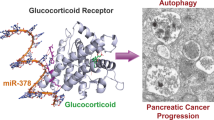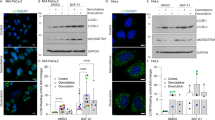Abstract
Lumican, an extracellular matrix proteoglycan overexpressed by pancreatic stellate cells (PSCs) and pancreatic ductal adenocarcinoma cells (PDACs), drives the formation of a tumor-specific microenvironment. We recently showed that extracellular lumican inhibits pancreatic cancer cell growth and is associated with prolonged survival after surgery. Here we investigated the role of extracellular lumican in chemotherapy-mediated cancer therapy. Lumican secretion was increased by chemotherapeutic agents in PDAC, and especially in PSCs, and appeared to be linked to the extent of cells’ response to chemotherapy-induced growth inhibition. In multiple PDAC models, including cell lines, patient-derived xenografts and lumican knockout mice, lumican significantly increased antitumor effect of chemotherapy. This effect was associated with DNA damage, apoptosis and inhibition of cell viability, glucose consumption, lactate production and vascular endothelial growth factor secretion. In PDAC cells, chemotherapeutic agents triggered autophagosome formation and increased LC3 expression through the reactive oxygen species-mediated AMP-activated kinase (AMPK) signaling pathway. Inhibition of gemcitabine-induced autophagy in cancer cells by treatment with AMPK inhibitor compound C, lysosomal inhibitor chloroquine or autophagy inhibitor 3MA enhanced gemcitabine-induced apoptosis, suggesting that autophagy is a protective cellular response to gemcitabine treatment. Importantly, lumican dramatically decreased AMPK activity, inhibiting chemotherapy-induced autophagy in both in vitro and in vivo PDAC models. Co-treatment of PDAC cells with lumican and gemcitabine increased mitochondrial damage, reactive oxygen species (ROS) production and cytochrome c release, indicating that lumican-induced disruption of mitochondrial function may be the mechanism of sensitization to gemcitabine. Together, our findings demonstrate that extracellular lumican augments cytotoxicity of chemotherapy in PDAC cells through inhibition of chemotherapeutic agent-induced autophagy.
This is a preview of subscription content, access via your institution
Access options
Subscribe to this journal
Receive 50 print issues and online access
$259.00 per year
only $5.18 per issue
Buy this article
- Purchase on Springer Link
- Instant access to full article PDF
Prices may be subject to local taxes which are calculated during checkout







Similar content being viewed by others
References
Jemal A, Bray F, Center MM, Ferlay J, Ward E, Forman D . Global cancer statistics. CA Cancer J Clin 2011; 61: 69–90.
Siegel R, Naishadham D, Jemal A . Cancer statistics, 2013. CA Cancer J Clin 2013; 63: 11–30.
Hamada S, Masamune A, Shimosegawa T . Novel therapeutic strategies targeting tumor-stromal interactions in pancreatic cancer. Front Physiol 2013; 4: 331.
Berlin JD, Catalano P, Thomas JP, Kugler JW, Haller DG, Benson AB 3rd . Phase III study of gemcitabine in combination with fluorouracil versus gemcitabine alone in patients with advanced pancreatic carcinoma: Eastern Cooperative Oncology Group Trial E2297. J Clin Oncol 2002; 20: 3270–3275.
Herrmann R, Bodoky G, Ruhstaller T, Glimelius B, Bajetta E, Schuller J et al. Gemcitabine plus capecitabine compared with gemcitabine alone in advanced pancreatic cancer: a randomized, multicenter, phase III trial of the Swiss Group for Clinical Cancer Research and the Central European Cooperative Oncology Group. J Clin Oncol 2007; 25: 2212–2217.
Li X, Truty MJ, Kang Y, Chopin-Laly X, Zhang R, Roife DJ et al. Extracellular lumican inhibits pancreatic cancer cell growth and is associated with prolonged survival after surgery. Clin Cancer Res 2014; 20: 6529–6540.
Erkan M, Adler G, Apte MV, Bachem MG, Buchholz M, Detlefsen S et al. StellaTUM: current consensus and discussion on pancreatic stellate cell research. Gut 2012; 61: 172–178.
Apte MV, Park S, Phillips PA, Santucci N, Goldstein D, Kumar RK et al. Desmoplastic reaction in pancreatic cancer: role of pancreatic stellate cells. Pancreas 2004; 29: 179–187.
Vonlaufen A, Joshi S, Qu C, Phillips PA, Xu Z, Parker NR et al. Pancreatic stellate cells: partners in crime with pancreatic cancer cells. Cancer Res 2008; 68: 2085–2093.
Masamune A, Shimosegawa T . Pancreatic stellate cells—multi-functional cells in the pancreas. Pancreatology 2013; 13: 102–105.
Erkan M, Kleeff J, Gorbachevski A, Reiser C, Mitkus T, Esposito I et al. Periostin creates a tumor-supportive microenvironment in the pancreas by sustaining fibrogenic stellate cell activity. Gastroenterology 2007; 132: 1447–1464.
Ozdemir BC, Pentcheva-Hoang T, Carstens JL, Zheng X, Wu CC, Simpson TR et al. Depletion of carcinoma-associated fibroblasts and fibrosis induces immunosuppression and accelerates pancreas cancer with reduced survival. Cancer Cell 2014; 25: 719–734.
Rhim AD, Oberstein PE, Thomas DH, Mirek ET, Palermo CF, Sastra SA et al. Stromal elements act to restrain, rather than support, pancreatic ductal adenocarcinoma. Cancer Cell 2014; 25: 735–747.
Coulson-Thomas VJ, Coulson-Thomas YM, Gesteira TF, Andrade de Paula CA, Carneiro CR, Ortiz V et al. Lumican expression, localization and antitumor activity in prostate cancer. Exp Cell Res 2013; 319: 967–981.
Iozzo RV . Matrix proteoglycans: from molecular design to cellular function. Annu Rev Biochem 1998; 67: 609–652.
Chakravarti S, Magnuson T, Lass JH, Jepsen KJ, LaMantia C, Carroll H . Lumican regulates collagen fibril assembly: skin fragility and corneal opacity in the absence of lumican. J Cell Biol 1998; 141: 1277–1286.
Nikitovic D, Katonis P, Tsatsakis A, Karamanos NK, Tzanakakis GN . Lumican, a small leucine-rich proteoglycan. IUBMB Life 2008; 60: 818–823.
Baba H, Ishiwata T, Takashi E, Xu G, Asano G . Expression and localization of lumican in the ischemic and reperfused rat heart. Jpn Circ J 2001; 65: 445–450.
Lu YP, Ishiwata T, Kawahara K, Watanabe M, Naito Z, Moriyama Y et al. Expression of lumican in human colorectal cancer cells. Pathol Int 2002; 52: 519–526.
Ishiwata T, Cho K, Kawahara K, Yamamoto T, Fujiwara Y, Uchida E et al. Role of lumican in cancer cells and adjacent stromal tissues in human pancreatic cancer. Oncol Rep 2007; 18: 537–543.
Bin-Umer MA, McLaughlin JE, Butterly MS, McCormick S, Tumer NE . Elimination of damaged mitochondria through mitophagy reduces mitochondrial oxidative stress and increases tolerance to trichothecenes. Proc Natl Acad Sci USA 2014; 111: 11798–11803.
Kurihara Y, Kanki T, Aoki Y, Hirota Y, Saigusa T, Uchiumi T et al. Mitophagy plays an essential role in reducing mitochondrial production of reactive oxygen species and mutation of mitochondrial DNA by maintaining mitochondrial quantity and quality in yeast. J Biol Chem 2012; 287: 3265–3272.
Sui X, Chen R, Wang Z, Huang Z, Kong N, Zhang M et al. Autophagy and chemotherapy resistance: a promising therapeutic target for cancer treatment. Cell Death Dis 2013; 4: e838.
Kondo Y, Kanzawa T, Sawaya R, Kondo S . The role of autophagy in cancer development and response to therapy. Nat Rev Cancer 2005; 5: 726–734.
Maycotte P, Thorburn A . Autophagy and cancer therapy. Cancer Biol Ther 2011; 11: 127–137.
Janku F, McConkey DJ, Hong DS, Kurzrock R . Autophagy as a target for anticancer therapy. Nat Rev Clin Oncol 2011; 8: 528–539.
Shackelford DB, Shaw RJ . The LKB1-AMPK pathway: metabolism and growth control in tumour suppression. Nat Rev Cancer 2009; 9: 563–575.
Hardie DG . AMP-activated protein kinase: an energy sensor that regulates all aspects of cell function. Genes Dev 2011; 25: 1895–1908.
Hardie DG . AMPK: positive and negative regulation, and its role in whole-body energy homeostasis. Curr Opin Cell Biol 2014; 33C: 1–7.
Shaw RJ . LKB1 and AMP-activated protein kinase control of mTOR signalling and growth. Acta Physiol (Oxf) 2009; 196: 65–80.
Rehman G, Shehzad A, Khan AL, Hamayun M . Role of AMP-activated protein kinase in cancer therapy. Arch Pharm (Weinheim) 2014; 347: 457–468.
Zhu H, Moriasi CM, Zhang M, Zhao Y, Zou MH . Phosphorylation of serine 399 in LKB1 protein short form by protein kinase Czeta is required for its nucleocytoplasmic transport and consequent AMP-activated protein kinase (AMPK) activation. J Biol Chem 2013; 288: 16495–16505.
Masamune A, Shimosegawa T . Signal transduction in pancreatic stellate cells. J Gastroenterol 2009; 44: 249–260.
Kim MP, Truty MJ, Choi W, Kang Y, Chopin-Lally X, Gallick GE et al. Molecular profiling of direct xenograft tumors established from human pancreatic adenocarcinoma after neoadjuvant therapy. Ann Surg Oncol 2012; 19(Suppl 3): S395–S403.
Kim MP, Evans DB, Wang H, Abbruzzese JL, Fleming JB, Gallick GE . Generation of orthotopic and heterotopic human pancreatic cancer xenografts in immunodeficient mice. Nat Protoc 2009; 4: 1670–1680.
Li X, Lu Y, Lu H, Luo J, Hong Y, Fan Z . AMPK-mediated energy homeostasis and associated metabolic effects on cancer cell response and resistance to cetuximab. Oncotarget 2015; 6: 11507–11518.
Acknowledgements
This work was supported by grants from the Viragh Family Foundation (to JF), the W. Smith Foundation (to JF) and National Institutes of Health (NIH) grant T32CA009599 (to DR).
Author information
Authors and Affiliations
Corresponding author
Ethics declarations
Competing interests
The authors declare no conflict of interest.
Rights and permissions
About this article
Cite this article
Li, X., Roife, D., Kang, Y. et al. Extracellular lumican augments cytotoxicity of chemotherapy in pancreatic ductal adenocarcinoma cells via autophagy inhibition. Oncogene 35, 4881–4890 (2016). https://doi.org/10.1038/onc.2016.20
Received:
Revised:
Accepted:
Published:
Issue Date:
DOI: https://doi.org/10.1038/onc.2016.20
This article is cited by
-
The Downregulation of Placental Lumican Promotes the Progression of Preeclampsia
Reproductive Sciences (2021)
-
Gambogic acid induces autophagy and combines synergistically with chloroquine to suppress pancreatic cancer by increasing the accumulation of reactive oxygen species
Cancer Cell International (2019)
-
Hypoxia-induced autophagy of stellate cells inhibits expression and secretion of lumican into microenvironment of pancreatic ductal adenocarcinoma
Cell Death & Differentiation (2019)
-
Lumican delays melanoma growth in mice and drives tumor molecular assembly as well as response to matrix-targeted TAX2 therapeutic peptide
Scientific Reports (2017)
-
Prolonged exposure to extracellular lumican restrains pancreatic adenocarcinoma growth
Oncogene (2017)



